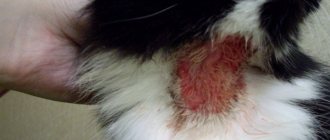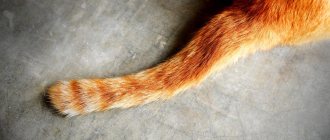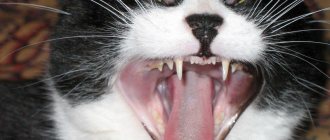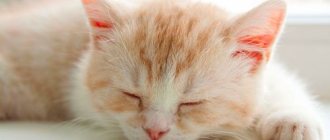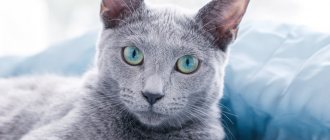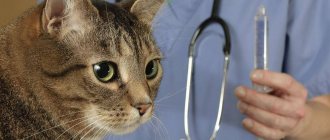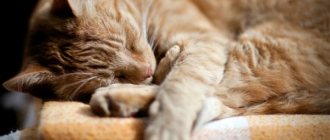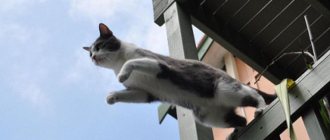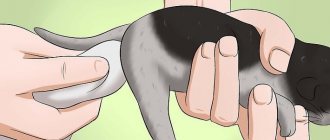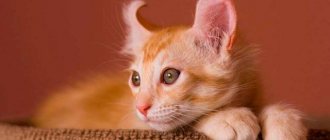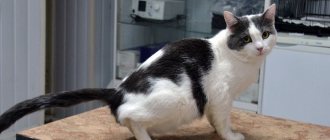Foaming at the mouth of a cat should be a reason to monitor your pet more closely. The causes of this phenomenon can be both harmless physiological phenomena and serious diseases. It is important to pay attention to the presence of accompanying symptoms in order to promptly contact a veterinary clinic if necessary.
Common reasons
What was the exact provoking factor for the cat to start foaming at the mouth can only be determined by a specialist. This is because there are a very large number of reasons, and they are not always harmless, just as they are not always catastrophically dangerous. Foaming at the mouth of a small kitten can occur under the same circumstances as in an adult pet.
Physiological factors:
Foamy saliva during pregnancy. Cats also experience a condition similar to female toxicosis during pregnancy. Most often, this phenomenon is observed in the morning, after each awakening from sleep or almost immediately after eating. There may be a color change to slightly yellowish or the color of the food you eat. The general condition of the cat does not change; appetite and activity are preserved.- Sometimes a very strong nervous shock or stress can provoke the release of foam in the corners of the mouth. Usually it is so minor that the condition can be considered simply as increased salivation. It may go unnoticed.
- Foam mixed with wool is typical for long-haired breeds. This is a sign that the pet has licked or swallowed its own hairs, which, irritating the mouth and stomach, cause increased salivation and/or vomiting. There is always fur in the vomit, the foamy contents are white, and cases are most often one-time. This also does not affect the general condition of the cat; the level of vital activity remains at the same level after the stomach has emptied of fur.
- White foam that appears once may be evidence that the mustachioed pet has been starving for a long time and has an empty stomach. Excess gastric juice accumulates in the stomach, which begins to irritate the surface of its mucosa. This provokes excessive production of protective mucus, which, mixed with gastric juice and air, forms foam and is expelled through vomiting.
- The discharge of foamy liquid from the mouth always accompanies a reaction to any bitterness - for example, bitter medicines (syrups or tablets). Bitters should be taken with plenty of water. At the same time, the general condition of the animal does not deteriorate; it usually drinks, eats and behaves.
Pathologies of the oral cavity and gastrointestinal tract:
- The release of foam can be explained by pathologies of the oral cavity (for example, stomatitis or a foreign body in the soft tissues of the mouth). These moments are always accompanied by intense production of saliva, which, interacting with air, is converted into foam. To confirm this reason, it is enough to simply examine the animal’s oral cavity.
- Green or whitish foam, which is mixed with green vomit, indicates a violation of the digestive process, when food from the intestinal tract is thrown back into the stomach along with bile and provokes vomiting. This is already a reason to contact a veterinarian to find out the cause of such a violation, because... Along with simply eating green grass, this may be a sign of a severe digestive system infection or intestinal blockage.
- If pink or red foam appears, this is the first sign of bleeding. Based on the shade and intensity of the color of the foamy saliva, one can guess where the source of the bleeding is and what the cause of this condition is. A faint pink color may indicate minor injuries or mouth ulcers. It is enough to examine the mouth to detect the source of bleeding. Bright red foam may indicate bleeding in the esophagus due to the presence of foreign bodies and/or internal trauma (for example, from bones). If there is a brown tint, then this is a signal of problems with the stomach (peptic ulcer or gastritis) or with the liver (hepatitis). If there is red or brown foam, you do not need to try to help yourself; you need to contact a veterinarian.
Gastritis or injury?
Foaming mixed with blood can be caused by:
- Injuries (caused by bones or other sharp and hard components of the cat’s diet);
- entry of a foreign object into the esophagus;
- stomach ulcers;
- intestinal perforation;
- gastritis;
- liver diseases.
You can independently determine the cause by the color of the blood. Red and bright red - indicate the first two possible reasons; brown – about the latest factors. Spots of scarlet blood indicate bleeding in the throat or esophagus, and clots indicate problems in the stomach area. Bloody threads are often the result of a bone stuck in the throat and scratched. In any case, such a phenomenon should not go unnoticed, and the cat should be taken to a veterinary clinic.
We suggest you read: Worms in calves, symptoms, treatment
When foaming at the mouth is a sign of serious illness
The basic rule in which foaming from the mouth may indicate serious problems in the pet’s health is any accompanying symptoms that change the general condition of the animal (loss of consciousness, convulsions, unsteady gait, etc.) and a high frequency of foaming. In such conditions, providing independent assistance is not advisable; it is necessary to show the mustachioed pet to a veterinary specialist as soon as possible.
- Any severe poisoning with toxic substances (for example, rat poisons or household chemicals) or overdose of certain medications is often accompanied by the release of foamy saliva. In the future, this phenomenon may be accompanied by vomiting, diarrhea, unsteady gait, dilated pupils, sometimes convulsions or loss of consciousness.
- Epileptic seizures in cats are also accompanied by the release of foam from the mouth, as well as convulsions, involuntary emptying of the bladder and intestines, and tension in the limbs. Foamy discharge may change color to pinkish - a sign that there is blood in the oral cavity (for example, biting the tongue, the inside of the cheeks or lips).
- Late stage rabies is manifested by foaming and profuse salivation. In addition to these signs, the sick animal has hydrophobia, paralysis of the lower jaw and the inability to swallow (Murka appears to have choked). In case of rabies, the presence of foam from the mouth is already a guarantee that the animal will die. Always with foam at the mouth and convulsions, rabies is first ruled out, because The disease is also dangerous for humans.
- The cat is foaming at the mouth with increased salivation due to panleukopenia (feline distemper in common parlance) - a serious viral infection, which is additionally accompanied by an increase in body temperature, discharge from the eyes and nose. The color of the foamy discharge is white, without impurities in color or composition. The immune system suffers greatly, intensive therapy is required, otherwise death cannot be avoided.
- Inflammation of the meninges and concussion are also accompanied by the release of foam from the mouth and nervous disorders (convulsions, tics, unsteadiness of gait).
- Severe pain of any localization can be accompanied by the formation of foam from the cat’s mouth. Especially pain in the head area (otitis media, toothache). In this case, the animal takes a forced position, tries to move less, and tremors may appear in the body.
- Helminthic infestations - with severe infection, vomiting may occur directly in foam, in which parasites are directly detected. In this condition, self-prescription of anthelmintic drugs is prohibited!
Contacting a veterinarian
You should seek help from a veterinarian when your cat has:
- regular foamy discharge from the mouth;
- severe vomiting, convulsions, elevated body temperature, eyes become white or cloudy;
- strong changes in the animal’s behavior were noticeable, which was not typical for her.
When a deterioration in the health of a pet is noticed, the main thing is not to do anything until the doctor arrives, especially not to give any medications, because they can greatly change the overall picture of what is happening and not always for the better.
By following all the recommendations and warnings, in most cases the animal can be cured as soon as possible.
Whatever happens to their pets, owners must remain calm and rational in their thinking in order to understand what happened and provide the necessary first aid in a timely manner. What to do if your cat starts foaming at the mouth, and how to understand the cause of this phenomenon so as not to miss a serious illness.
What to do
- If the owner knows that the cause of the phenomenon is fur, he should clear the mouth of hairs and/or wait until the vomiting ends, during which the fur will come out on its own. Afterwards, it is advisable to purchase and give a special paste to remove hair from the cat’s body naturally. Before purchasing the paste, it is enough to give your pet a teaspoon of Vaseline oil.
- If, upon examination of the oral cavity, signs of stomatitis are found, you need to contact a veterinary hospital to prescribe adequate therapy (usually antibiotics, antiseptic and wound-healing pastes and ointments are prescribed).
- If there is a suspicion of an epileptic seizure, the animal is carefully laid on its side on a flat, hard surface, and all possibilities of injury from hitting surrounding objects at the time of convulsions are excluded. You need to wait until the attack ends and take the cat to the veterinary clinic.
- If there is a suspicion that your pet has become infected with an infectious disease, then it is not advisable to take any independent measures; you need the help of a specialist. Depending on the type of infection, antibiotics, antiviral agents, restorative and immunostimulating drugs, rehydrating droppers, etc. are prescribed.
- If there is a suspicion that the cat/cat/kitten has been poisoned, it is necessary to induce vomiting or wait until it ends, give any sorbent that is in the first aid kit (activated carbon or polysorb) and take the animal to the veterinarian. If signs of poisoning are accompanied by damage to the nervous system (convulsions or loss of consciousness), then self-help is prohibited, only sending to a hospital!
- If the foam at the mouth is explained by the presence of a foreign object in the mouth or larynx, you need to start by monitoring the condition of the animal - sometimes in the process of natural vomiting the foreign body is removed without problems. If the traumatic element is in the mouth and can be easily removed on your own, there is no need to hesitate, you need to remove it. If the foreign body is invisible (but it is known for sure that it is there) or it is impossible to get it out on your own, there is no need to hesitate to visit a veterinarian.
- If worms are found in the foamy vomit, you should consult a veterinarian at the first opportunity about the name of the anthelmintic drug and carry out deworming. You can carefully collect the parasites with gloved hands in any small glass container and also show them to the veterinarian to determine their type and select a more accurate drug.
Important: examination and any manipulations with a pet who is foaming at the mouth should be carried out only with rubber gloves to prevent the animal from contracting possible infectious diseases (for example, such as rabies).
How to warn?
If you follow a number of preventive measures, it is quite possible to avoid such an unpleasant phenomenon as foaming at the mouth:
- Regularly and thoroughly comb long-haired pets and periodically give a special paste to remove hair from the stomach naturally.
- Avoid feeding food that can injure the mucous membrane of the esophagus or oral cavity, causing inflammation and excessive production of saliva.
- Keep household chemical liquids and household poisons out of reach to avoid accidental ingestion by your cat.
- The use of any medications is allowed only with the prescription of a veterinarian and in dosages also specified by the veterinarian. Give bitter medicines with plenty of liquid.
- Regularly and promptly vaccinate against infectious diseases that occur with such symptoms.
Prevention
It is always easier to prevent a disease than to treat it later, so to maintain your pet’s health you need to follow simple preventive measures:
- To prevent foam from appearing in the corners of the mouth, you need to regularly brush your pet's fur.
- The cat's food should have a fairly soft consistency. If your pet eats bones, you need to make sure that they do not injure the mucous membranes of the mouth, esophagus and stomach.
- Regular use of anthelmintic drugs will help avoid this problem, since sometimes a large accumulation of parasites leads to foamy discharge in the kitten.
- It is necessary to do regular medical examinations, which will help to notice the impending danger and begin timely treatment.
- It is necessary to monitor what your pet eats. If your cat is walking outside, you can hang a bell around its neck to prevent the possibility of poisoning from a sick mouse or bird.
- You need to buy food and medicine in specialized places, because there are currently many counterfeits on the market that can lead to a similar problem.
Regular examination and proper care of the animal will help to avoid such troubles, which frighten not only the owner, but also the pet.
Question answer
White foamy discharge from the cat's mouth and no other symptoms
Usually, a single appearance of white foam from a cat’s mouth indicates prolonged hunger or intense helminthic infestation. It is enough to give the animal something to drink and feed. If there is a suspicion of infection with worms, then you should take your pet to the veterinarian to select the correct anthelmintic agent and its dosage. The animal may also be in pain.
The cat is foaming at the mouth after taking medicine (after a pill)
This reaction occurs in two cases - either the dosage was calculated incorrectly and more medicine was given than necessary, or the drug itself tastes bitter. In case of an overdose of medications, you should go to the veterinary clinic. In the second case, it is enough to give water to drink (pour it into the mouth from a disposable syringe without a needle).
If your cat is having convulsions and is foaming at the mouth
Options: severe poisoning, epilepsy or other infectious disease accompanied by damage to the nervous system. Reason for an urgent visit to the veterinarian.
Foaming at the mouth along with vomiting
If you experience vomiting with foamy discharge, the options may be the following: hungry stomach cramps, blockage of the stomach or intestines, worms (can be found in the vomit directly in the foam). Vomiting with pink foam is evidence of the presence of bleeding, yellow or green - indigestion when bile or intestinal contents enter the stomach.
Pregnant cat foams at the mouth
Isolated cases of discharge from the mouth in pregnant women in the absence of any other accompanying signs are acceptable and are equated to a state of toxicosis. The general condition of the animal should not be disturbed.
Reasons if increased saliva secretion turns into foam
Pathologies of the oral cavity and upper gastrointestinal tract are almost always accompanied by profuse salivation. A large amount of saliva turns into foam upon contact with air.
Cat foams at the mouth after flea treatment
Most likely, the rules for applying blood-sucking insect repellent were violated. There are special points for applying the product in the withers area and along the spine, where Murka cannot lick it off. If applied incorrectly, apparently, the animal licked it off, which caused a similar reaction. The product can be safe, but bitter (just give it some extra water), it can be toxic and cause poisoning - you need the help of a specialist.
If you foam at the mouth after abdominal surgery (sterilization, for example)
Any abdominal surgical interventions must be performed under general anesthesia. Different cats also recover from anesthesia in completely different ways. Sometimes this process is accompanied by vomiting and/or increased production of foamy saliva. If nothing else bothers the animal, it is enough to give it liquid to drink and wait for the condition to normalize. If the process of recovery from anesthesia takes up to 1.5 days, then this is a reason to seek advice from a specialist.
Author:
Grinchuk Ekaterina Andreevna veterinarian
Poisoning
No matter how the owner monitors his pet’s diet, the cat can still swallow any toxic substance. Also, poisoning may not be of a food nature and, for example, occurs due to the absorption into the skin of poisons intended to eliminate fleas.
Common signs of poisoning are:
- Diarrhea;
- unsteady gait (swaying from side to side);
- frequent foamy vomiting.
Advice! Gastric lavage will help alleviate this condition of the animal. They can do it in any veterinary clinic under the strict supervision of doctors.
